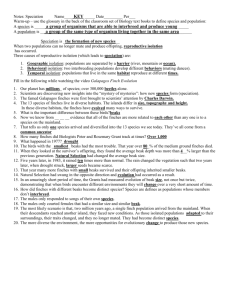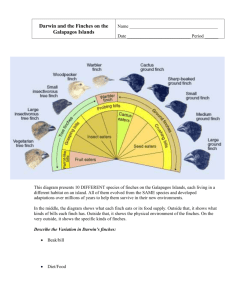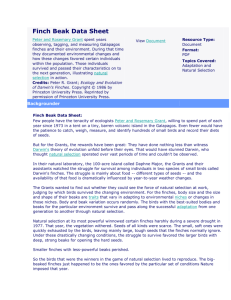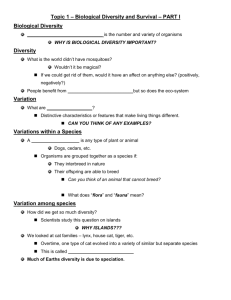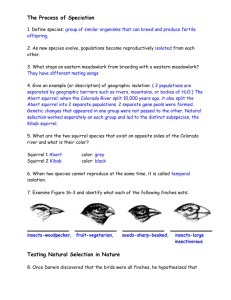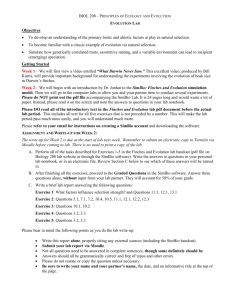answer key - the ant life
advertisement
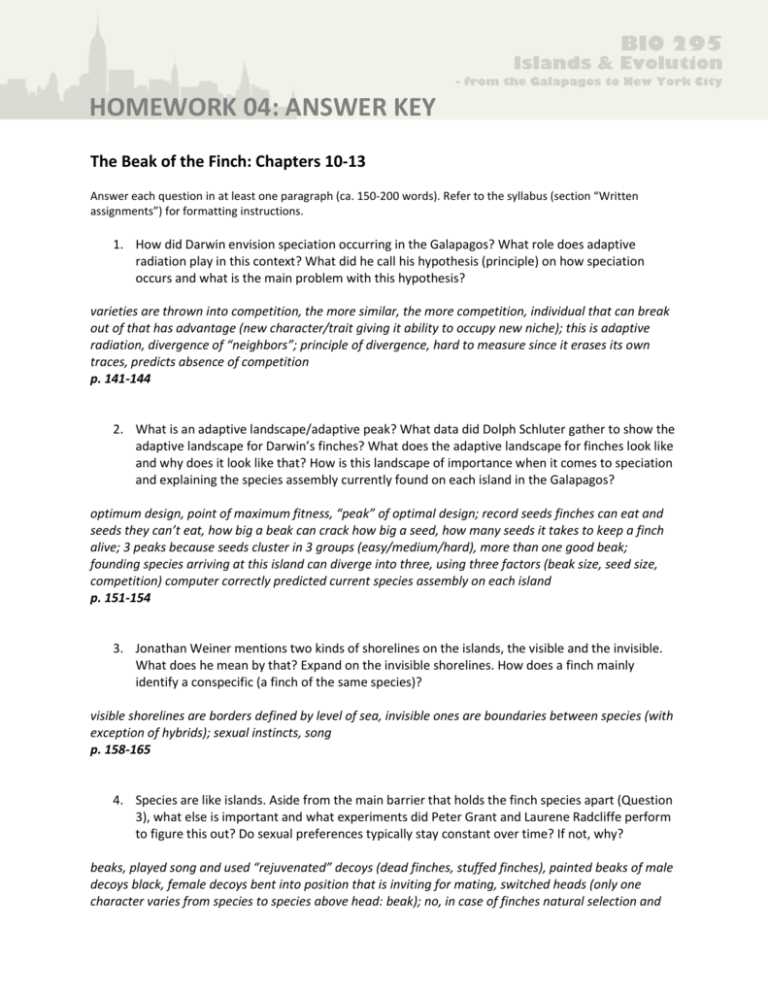
BIO 295 Islands & Evolution - from the Galapagos to New York City HOMEWORK 04: ANSWER KEY The Beak of the Finch: Chapters 10-13 Answer each question in at least one paragraph (ca. 150-200 words). Refer to the syllabus (section “Written assignments”) for formatting instructions. 1. How did Darwin envision speciation occurring in the Galapagos? What role does adaptive radiation play in this context? What did he call his hypothesis (principle) on how speciation occurs and what is the main problem with this hypothesis? varieties are thrown into competition, the more similar, the more competition, individual that can break out of that has advantage (new character/trait giving it ability to occupy new niche); this is adaptive radiation, divergence of “neighbors”; principle of divergence, hard to measure since it erases its own traces, predicts absence of competition p. 141-144 2. What is an adaptive landscape/adaptive peak? What data did Dolph Schluter gather to show the adaptive landscape for Darwin’s finches? What does the adaptive landscape for finches look like and why does it look like that? How is this landscape of importance when it comes to speciation and explaining the species assembly currently found on each island in the Galapagos? optimum design, point of maximum fitness, “peak” of optimal design; record seeds finches can eat and seeds they can’t eat, how big a beak can crack how big a seed, how many seeds it takes to keep a finch alive; 3 peaks because seeds cluster in 3 groups (easy/medium/hard), more than one good beak; founding species arriving at this island can diverge into three, using three factors (beak size, seed size, competition) computer correctly predicted current species assembly on each island p. 151-154 3. Jonathan Weiner mentions two kinds of shorelines on the islands, the visible and the invisible. What does he mean by that? Expand on the invisible shorelines. How does a finch mainly identify a conspecific (a finch of the same species)? visible shorelines are borders defined by level of sea, invisible ones are boundaries between species (with exception of hybrids); sexual instincts, song p. 158-165 4. Species are like islands. Aside from the main barrier that holds the finch species apart (Question 3), what else is important and what experiments did Peter Grant and Laurene Radcliffe perform to figure this out? Do sexual preferences typically stay constant over time? If not, why? beaks, played song and used “rejuvenated” decoys (dead finches, stuffed finches), painted beaks of male decoys black, female decoys bent into position that is inviting for mating, switched heads (only one character varies from species to species above head: beak); no, in case of finches natural selection and sexual selection both focus on beaks (and selection pressures change over time), arrangements and behaviors are not permanent, borders between species are fluid and adaptable p. 165-172 5. There are three examples of recent divergence and subsequent speciation/adaptive radiation (i.e. evolution in action) mentioned in Chapter 12 (Drosophila paulistorum complex, crossbills, sticklebacks). Choose one example that you find the most intriguing and explain it in greater detail including experiments that were performed. (Consider the word limit as a reference for the level of detail expected.) Drosophila paulistorum complex: cluster of 6 populations that are partly isolated (by build & behavior, “too distinct to be considered races, not distinct enough to be regarded full species”), within 5 years reproductive isolation documented, new species formed, possibly driven by bacterial infection p. 178-180 Crossbills: group of finches where tips of beaks are crossed over, beaks are adaptive, allow them to open cones, different sized beaks open different sized cones, experiment: trim beaks so no longer crossed, first crossed beaked bird possibly appeared as “hopeful monster”, perfected over generations by natural selection p. 182-184 Sticklebacks: most lakes have one species but some have pair of species, bottom-feeders (benthics) & water-column-feeders (limnetics), similar measurements and results to finches (gill rakers instead of beaks) p. 184-189 6. Why haven’t the cactus finches changed over the course of the finch study? Why have fortis been able to change? Put this into the context of the adaptive landscapes of these two species. changes in adaptive landscapes of both species, fewer cactus trees, fruits and seeds, number of cactus finches has declined, haven’t changed because they have nowhere to go, have gone down along with their adaptive peak; fewer big, hard seeds on island since flood, more small, soft seeds, fortis shifted toward larger size, then toward smaller size; one adaptive peak collapsed, other peak has expanded, cactus finches have gone down with their peak, fortis have evolved (“rolled with adaptive landscape”) p. 191-193 7. What feature does hybridization add to a population and why is this important in terms of evolution? Explain this with the help of the example on fruit flies in Australia used in the book (Dacus tryoni & D. neohumeralis). add variation (important for evolution), influx of new genes, hybrids may have advantage in a changing landscape; two species of fruit flies have moved out of forest into orchards, live side by side, held apart by gene flow barrier: temporal isolation (one species breeds in morning, other breeds in evening), hybridization occurs occasionally, exchange of genes not enough to merge species, but enough to introduce new (beneficial) alleles into population, this introgression might have led to rapid adaptation of flies, natural selection holds the species apart p. 193-202
